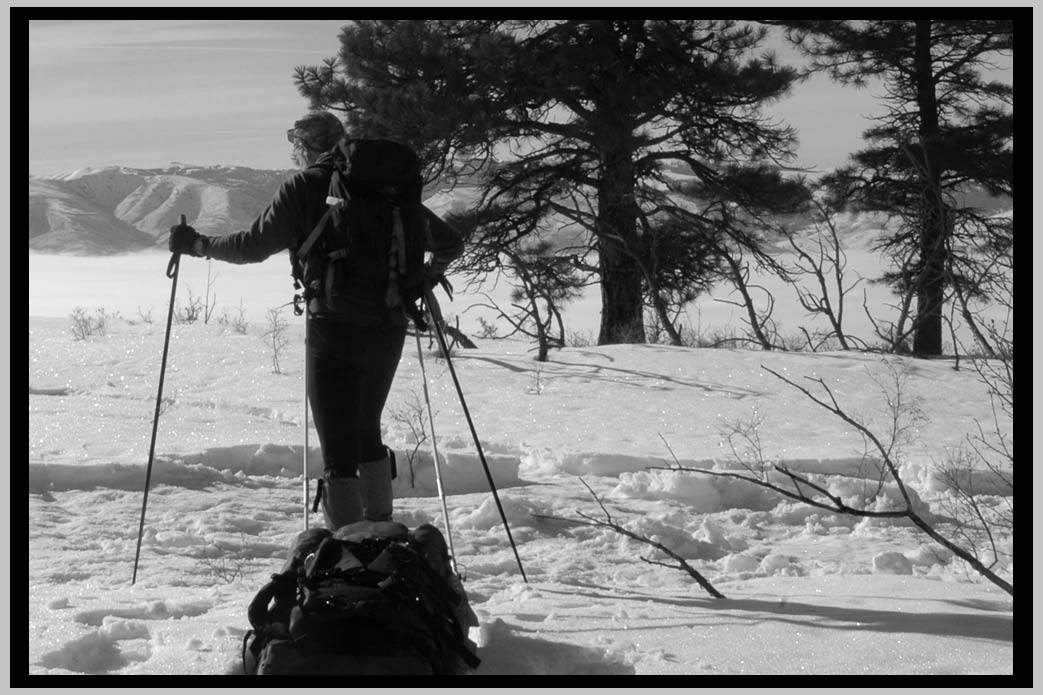

Breaking Winter Camp, on the way to the Eagle Cap Wilderness [click photo for next . . . ]


Breaking Winter Camp, on the way to the Eagle Cap Wilderness [click photo for next . . . ]
Stable high-pressure weather and good, safe snow. What more can
one ask! To get up to the wilderness from here is another two-day trek. I call my sled
setup "the stationwagon." I can pull as much as 40 / 50 k, both with AT skis and
snowshoes, but prefer the latter if the load is really heavy. I call it my stationwagon
because I feel so self-contained when out with it, and well, as anyone who has skied
with a heavy pack knows, you tend not to want to stop and take the pack off
for a while because it's too much work. But with the sled, I don't think twice.
I just release the harness and dump the small climbing pack in one unit, and
sit right on top of the gear, to one side. And have something to drink. I always
have hot chai tea ready in a thermos, as well as a meltwater energy drink
of some kind. Managing drink water, both in and between camps is a real
art form. All water above 1500 m. in winter comes from snow, melting
it at night and first thing in the morning. So the abstract concept of snow
water equivalent becomes, after a week or two of this, completely second
nature.
On the road in the American Northwest.
LOGISTICS
Getting ready for a trek: A thousand things to do and pack up; and a
thousand things to remember. From the calm, near-timeless summit
of overview, we have order. But in the lowlands of practical reality,
where things must be done necessarily one at a time, we have chaos.
The problem is simple: regardless of how many thoughts you may
have, and regardless of how fast you can write or type—look at a
Mozart manuscript!—they can still only be written down one letter,
one word, one note at a time. Just as when you’re packing up gear and
food for a trip, all the myriad things on your list of stuff to be done can
only be ‘walked through,’ as it were, one step at a time. What to do?
In teaching, whether it be a young student or just oneself, I’ve come
to think that it is important to practice—actually practice like a pianist
practices an etude—making a pause or stopping at regular intervals.
Why? Because in the interval of the pause we can observe this nearly
universal tendency to run away in an accelerating loop of impatience,
or as they say in the Alexander Technique (AT), end-gain a goal, or
point of completion. I’ve noticed too that, when the mind runs ahead
to the summit when the feet are still in tough and unpredictable terrain,
that this is when you’re most likely to make a mistake. The pause helps
you anchor your feet in the present moment, from which point we can
quietly consider the lay of the terrain ahead. And that can make all the
difference.
[Note: Why will current western culture fail to manifest the tremendous potential
of computers and parallel processing? Because it has lost the once
highly refined discipline and sense of the art of polyphony and counterpoint.
With multitasking, musicians learn to conduct 4 in the time of 5 and read the
New York Times effortlessly all at once. But even Bach could not handle
more than six voices. I would say: learn to first program two processors like
a real virtuoso! The rest will take care of itself.]
SNOW COCKTAIL
Zinc from China,
Cadmium from Japan.
Atrazine from the Basel.
Mercury from Seattle,
Lead from Detroit.
Snow cocktail of the High Wallowas,
pure spring water mixed with crushed snow,
these drifts that linger into the lazy heat of July.
Clear. Cool. Refreshing.
I drink to your health, friend.
For better or worse, we’re in this together,
married to the oneness of the world.
VIII.21.2009,
Camp Lost & Found,
Eagle Cap Wilderness
THE LITTLE CLAVIER please preview 150 of 631 pages
w/ my black & white photography [opens in new window]
